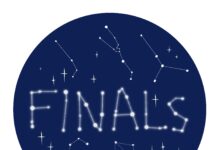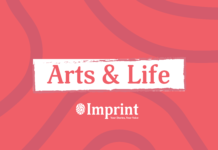The department of drama and speech communication hosted its third annual Pop-Up Museum March 28, and asked: How can we better understand the relationship between the lived and the virtual through the lens of art? </p>
The Pop-Up Museum aimed to investigate our online worlds and our lived experiences in the physical world — and artistically blurred the lines between the two. The show created a hybrid space where audiences engaged and interacted with artists’ depictions and critiques of social media. It also incorporated unconventional representations of performance art and street art, and playfully considered the function of institutionalized spaces like universities, art galleries, and museums as arbitrators of cultural knowledge.
Students took part in the show as part of the final project for the SPCOM 491 course, taught by Prof. Shana MacDonald. The objective she expected students to meet through the project is “to create [artwork] that [communicates] different ideas about their and others’ cultural experiences. I hope that their work opens up dialogues with the audience so that productive conversations can unfold during the event and after.”
She added that the show is unique because “these are not fine art students; they have never made art in this capacity before and so they are translating ideas and core concerns of the speech communications discipline into visual form. It is a new experience for them!”
The pieces presented by artists were not ones usually seen in art exhibitions; eccentric and off-beat, each piece drew the audience in and required them to engage with it. Instagallery by Kaitlyn Skelly and Natalie Sadowski presented a series of Instagram pictures as a narrative story, starting with cliché, “basic” Instagram posts to increasingly critical ones. Handed stickers of emoticons, the audience interacted with the pieces by sticking the emoticons directly onto the posts, rather than sending them via phones.
Canadian/Dynamic/Mosaic by Babena Sriparamananthan, Jasleen Singhm Nigel Harrilall, and S. S. Ahmad portrayed the “fusion and evolution of different cultures within Canada [that] has led to a dynamic cultural mosaic,” as described by a musuem brochure. They presented an outline of the Canadian flag drawn with henna, which audiences were encouraged to fill in using Rangoli colours, representing the changes individuals go through to create a new identity by combining their “homeland and host land.” Harrilall added a musical feel to the show through a combination of the Tabla, a traditional South Asian drum, and Western music like “Hotline Bling” and “American Idiot,” creating a fusion of the two in order to represent cultural co-existence. He was inspired by Toronto-based artist Shobhit Banwait, who released tabla covers of songs by Fetty Wap and Calvin Harris, among others.
Chantaine Green-Leach, in her piece called Thanks for Asking, drew her inspiration from the works of Kara Walker and Lorna Simpson, and her five years of experience as a student at UW. Her piece critiqued the preoccupation non-black people have with black hair, and the invasion of privacy people of colour often face when people touch their hair without their permission. The piece consisted of tactile representations of black women’s hair that you were encouraged to touch; it was hooked up to pairs of headphones that played the phrase, “Yes, you can touch my hair, thanks for asking,” in multiple languages. Green-Leach described that there is a lack of awareness about this issue at UW, and hoped to tackle this by being “tasteful without being the angry black chick.” Her piece, according to the brochure, “implores the viewer to understand the harm that comes from freely exploring ‘territory’ that isn’t theirs without the consent of the owner of that ‘land’.”
The show also housed various other pieces such as The Gallery of Random Shit and Finding Happiness in a Ball Pit. Kavi Anand and Ashley Lee created a large-scale Instagram frame placed at the entrance of the show.
“Our audience will be forced to step through the frame, where the image would originally be, to view the museum. It is framing, both literally and figuratively, the entire show,” Anand said.
“We have each taken something that is important to us, both collectively and as individuals, and created something out of it. As a result, there is a sense of camaraderie between us. We are all in this together. We all want to see the best the class has to offer,” said Andrew Labre, creator of Everyone’s Mad.






























